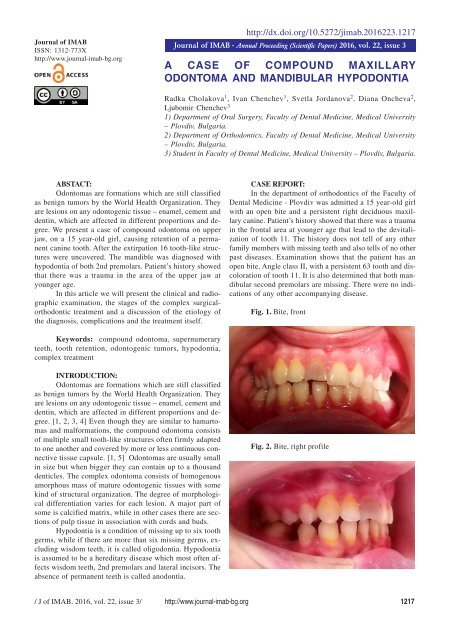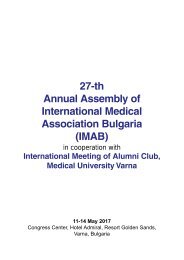JofIMAB-2016-vol22-issue3
Create successful ePaper yourself
Turn your PDF publications into a flip-book with our unique Google optimized e-Paper software.
Journal of IMAB<br />
ISSN: 1312-773X<br />
http://www.journal-imab-bg.org<br />
http://dx.doi.org/10.5272/jimab.<strong>2016</strong>223.1217<br />
Journal of IMAB - Annual Proceeding (Scientific Papers) <strong>2016</strong>, vol. 22, issue 3<br />
A CASE OF COMPOUND MAXILLARY<br />
ODONTOMA AND MANDIBULAR HYPODONTIA<br />
Radka Cholakova 1 , Ivan Chenchev 1 , Svetla Jordanova 2 , Diana Oncheva 2 ,<br />
Ljubomir Chenchev 3<br />
1) Department of Oral Surgery, Faculty of Dental Medicine, Medical University<br />
– Plovdiv, Bulgaria.<br />
2) Department of Orthodontics, Faculty of Dental Medicine, Medical University<br />
– Plovdiv, Bulgaria.<br />
3) Student in Faculty of Dental Medicine, Medical University – Plovdiv, Bulgaria.<br />
ABSTACT:<br />
Odontomas are formations which are still classified<br />
as benign tumors by the World Health Organization. They<br />
are lesions on any odontogenic tissue – enamel, cement and<br />
dentin, which are affected in different proportions and degree.<br />
We present a case of compound odontoma on upper<br />
jaw, on a 15 year-old girl, causing retention of a permanent<br />
canine tooth. After the extirpation 16 tooth-like structures<br />
were uncovered. The mandible was diagnosed with<br />
hypodontia of both 2nd premolars. Patient’s history showed<br />
that there was a trauma in the area of the upper jaw at<br />
younger age.<br />
In this article we will present the clinical and radiographic<br />
examination, the stages of the complex surgicalorthodontic<br />
treatment and a discussion of the etiology of<br />
the diagnosis, complications and the treatment itself.<br />
CASE REPORT:<br />
In the department of orthodontics of the Faculty of<br />
Dental Medicine - Plovdiv was admitted a 15 year-old girl<br />
with an open bite and a persistent right deciduous maxillary<br />
canine. Patient’s history showed that there was a trauma<br />
in the frontal area at younger age that lead to the devitalization<br />
of tooth 11. The history does not tell of any other<br />
family members with missing teeth and also tells of no other<br />
past diseases. Examination shows that the patient has an<br />
open bite, Angle class II, with a persistent 63 tooth and discoloration<br />
of tooth 11. It is also determined that both mandibular<br />
second premolars are missing. There were no indications<br />
of any other accompanying disease.<br />
Fig. 1. Bite, front<br />
Keywords: compound odontoma, supernumerary<br />
teeth, tooth retention, odontogenic tumors, hypodontia,<br />
complex treatment<br />
INTRODUCTION:<br />
Odontomas are formations which are still classified<br />
as benign tumors by the World Health Organization. They<br />
are lesions on any odontogenic tissue – enamel, cement and<br />
dentin, which are affected in different proportions and degree.<br />
[1, 2, 3, 4] Even though they are similar to hamartomas<br />
and malformations, the compound odontoma consists<br />
of multiple small tooth-like structures often firmly adapted<br />
to one another and covered by more or less continuous connective<br />
tissue capsule. [1, 5] Odontomas are usually small<br />
in size but when bigger they can contain up to a thousand<br />
denticles. The complex odontoma consists of homogenous<br />
amorphous mass of mature odontogenic tissues with some<br />
kind of structural organization. The degree of morphological<br />
differentiation varies for each lesion. A major part of<br />
some is calcified matrix, while in other cases there are sections<br />
of pulp tissue in association with cords and buds.<br />
Hypodontia is a condition of missing up to six tooth<br />
germs, while if there are more than six missing germs, excluding<br />
wisdom teeth, it is called oligodontia. Hypodontia<br />
is assumed to be a hereditary disease which most often affects<br />
wisdom teeth, 2nd premolars and lateral incisors. The<br />
absence of permanent teeth is called anodontia.<br />
Fig. 2. Bite, right profile<br />
/ J of IMAB. <strong>2016</strong>, vol. 22, issue 3/ http://www.journal-imab-bg.org 1217



